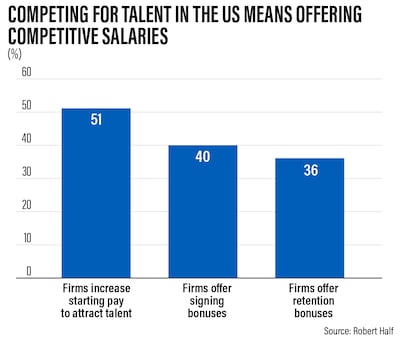Scroll down for detailed guides on salary brackets for various sectors
Employees in the US can look forward to an average salary rise of about 4 per cent in 2024, as continuing inflationary pressure and a tight labour market puts employers on notice to retain and attract talent, according to a report by global advisory company Willis Towers Watson.
However, this year’s 4 per cent increase is down from the 4.4 per cent average salary rise in 2023, WTW says in its Salary Budget Planning survey.
“We are seeing healthy salary increases forecasted for 2024,” says Hatti Johannsson, WTW’s research director for reward, data and intelligence.
“Though economic uncertainty looms, employers are looking to remain competitive for talent, and pay is a key factor.”
While inflation has eased in the world’s biggest economy, after hitting a peak of 9.1 per cent in June 2022, it remains above the US Federal Reserve’s 2 per cent target.
On Tuesday, the Labour Department said that February’s consumer price index rose to 3.2 per cent on an annual basis, up from 3.1 per cent in January.
Despite the Fed’s aggressive interest rate rises to cool the economy and ease the cost-of-living crisis, the jobs market has remained strong, with the US adding 275,000 jobs last month and unemployment coming in at 3.9 per cent, according to Labour Department data.
“At the same time, organisations should remember pay levels are difficult to reduce if markets deteriorate,” Ms Johannsson says.
“It’s best to avoid basing decisions that will have long-term implications on their organisation on temporary economic conditions.”
Meanwhile, the push for hybrid or remote working benefits continues in US workplaces, with half of the workers saying they would be willing to take a pay cut if they could work from anywhere, according to a survey by FlexJobs, a US-based subscription service for employees seeking flexible and remote jobs.
FlexJobs polled more than 4,200 employees in the US between February 6 and February 19 for its survey.
About 26 per cent of people surveyed said they would accept a 5 per cent pay cut and 25 per cent stated they would accept a salary decrease of either 10 per cent or 15 per cent, the survey found.
“Among generations, millennials showed the highest willingness to exchange key job factors, such as salary, chances for professional development and increased working hours, for a remote job without location restrictions,” FlexJobs said on Tuesday.
“Less than one third [31 per cent] of millennials said they wouldn’t give up anything for a work-from-anywhere job, compared to 41 per cent of Gen X and half [50 per cent] of boomers.”
The findings echo a separate survey by US recruitment specialist Onward Search, which found that 90 per cent of respondents to its Hiring Trends 2024 report would leave on-site jobs for remote opportunities.
What is the salary and employment outlook for jobseekers in the US in 2024? Read on to find out – and don’t forget to look at our detailed salary guides below for a snapshot of your industry.
Will salaries increase in 2024?
Yes, employees can expect an average salary rise of about 4 per cent in 2024 – slightly above the current inflation rate.
However, wage increases are likely to be more measured compared with recent years, according to recruitment specialist Robert Half.
“For some professionals, that might be a reason to look for other opportunities,” the company says in its 2024 Salary Guide.
“This is not lost on hiring managers, many of whom continue to increase compensation to retain key staff and better compete for top talent in a tight hiring market.”
Salary transparency is also becoming more important for jobseekers in 2024, with 42 per cent of workers expecting to see a salary range in a job posting and 57 per cent saying they would withdraw their application if an employer does not provide it upon request, the Robert Half research found.

Since the start of the year, eight US states and several cities have introduced pay disclosure laws that require salary ranges to be included in job advertisements, according to the Onward Search report.
“This year, US pay transparency laws and company policies are expected to multiply and hiring managers are increasingly disclosing pay upfront on their own accord,” Onward Search says.
Which sectors can expect the highest salary increases in 2024?
A salary rise is not always guaranteed and is dependent on several factors, including an employee’s ability to negotiate a higher wage, the sector they are working in, performance reviews, a company’s bottom line and whether or not their role is in demand.
According to research by Resume Genius, a US-based online resume builder, employees in the manufacturing, IT, legal, sales and healthcare sectors could see the biggest wage increases in 2024.
Some of the most in-demand jobs include lawyers and judicial law clerks, software and web developers, financial analysts and advisers, fitness workers, sales representatives, healthcare support occupations and designers, among others, Resume Genius says.
Despite the rise of artificial intelligence and the effect of the 2023 tech layoffs, there continues to be strong market demand for software and web development professionals, which is driving wage growth, it adds.
“The demand for software engineers and developers is projected to increase by 25 per cent over the next decade,” Resume Genius says.
Watch: UAE issues remote work visas
UAE to issue remote work visas

Meanwhile, more than 50 per cent of companies are planning to invest in artificial intelligence in 2024, which could result in 97 million new jobs by 2025, according to Onward Search.
New AI roles have already emerged, such as chief AI officers and AI prompt engineers, it adds.
“Emerging technologies have already advanced at an unprecedented rate in recent months and specialists predict that 2024 will bring more technological advancements than many creatives, marketers and even tech experts could imagine,” Onward Search says in its trends report.
What benefits can US jobseekers expect in 2024?
Employers are trying to strike a healthy balance within their total rewards packages and are focusing on non-monetary benefits to retain talent, according to WTW research.
This includes more workplace flexibility (63 per cent), a broader emphasis on diversity, equity and inclusion (60 per cent) and efforts to improve the employee experience (55 per cent), WTW says.
However, employees want benefits such as health insurance, retirement savings plans, paid time off, paid parental leave, remote work options and flexible work schedules to also be included in their remuneration packages, Robert Half says in its salary guide.
“Highly skilled professionals expect not just a base salary that’s in line with what other firms are offering but also a choice of benefits and perks that are equally competitive,” it says.
Will employees receive a bonus in 2024?
That remains to be seen, but if last year’s bonuses are anything to go by, then it might be a disappointing year for employees.
While year-end bonuses are an important retention tool and improve employee morale, a report by payroll company Gusto found that bonuses have fallen over the past two years, driven by a “stabilising labour market and squeeze on employers from inflation”.
“In 2023, year-end bonuses were down between 3.8 per cent and 36.2 per cent relative to 2022, and down between 12.3 per cent and 36.7 per cent relative to 2021,” it said in the report, which was published in January.
According to Gusto data, bonuses paid in December by companies registered on its platform averaged $2,145, a 21 per cent drop from the $2,730 average in December 2022.
US salary guide 2024
Check out our detailed salary guides below for a snapshot of how much you can expect to be paid in your sector this year.










